What a wonderful adventure a small group of ABW members had in the Greater Blue Mountains World Heritage Area where there are basically no trails but instead, an adventure playground for the fit, the cautious and the astute navigator. We returned scratched, battered and bruised so must have had a good time with a few of those “this looks doable moments” from the boys which equated to “what am I doing here” moments for me!
This place is not well known to many bushwalkers outside the NSW area but I was drawn to it after first reading about The Gardens of Stone National Park in “Great Walks” magazine. I was subsequent- ly lucky enough to join a couple of walks with the Upper Blue Mountains Bush Walking Club and the Bush Club while I was over there a year ago with the ARPA (Australian Retired Persons Association) camp at Blackheath.
This wetted my appetite and I wanted to show this extraordinary place to others, so I took up the challenge considering there is a dearth of informa- tion and no marked trails. Fortunately, I was able to source all walks except the Kanangra Walls to Katoomba (K2K) walk from one series of books called, “The Gardens of Stone National Park and Beyond”, by Michael Keates, Brian Fox and Yuri Bolotin. The books table the track notes of walks completed by Bush Club in the area together with some local history, the biodiversity and geo diversity of, what is often referred to as, “Pagoda Country”.
The weather was terribly hot to start with, it was March (2016) and we were clearly not used to the humidity so I had to modify our plans to avoid carrying extra water. We were consuming 3-4 litres during the day and taking in volumes of electrolytes.
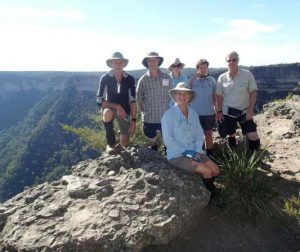
Kanangra Walls Lookout: Bruce Hood, Trevor Jones, Tracy Bryant, Jude Cahill, Tim Threlfall and Lorraine Thomas (seated). Photo by Nino Fioretti
Our first acclimatization walk started with Kanangra Walls to Katoomba in the Kanangra Boyd and Blue Mountains National Parks. Being in a remote wilderness area we were required to lodge a “Bushwalking & Activity Trip Intention Form” with the Katoomba Police. The weather was sunny at 30-32 degrees and water collection at Dex Creek and Mobbs Swamp were from very small decaying waterholes.
Overall this was a great walk over 4 days and was not without some difficult sections. The trail was easy to follow although not marked and only required attention to navigation in some parts to ensure we were going the right way. We did manage several side trips with a spectacular finish up Tarros Ladders involving pack hauling before a lengthy hike along Narrow Neck towards Katoomba. Surprisingly, we didn’t see another person until we arrived at the top of Tarros Ladders and that was because we had “invited” the Police Rescue Unit or rather they insisted on coming out.
To explain, Tim had severely sprained his ankle and bravely struggled with it for three days. It was very hot around 35 degrees and there was another 11kms of fire track to go. A big ask for someone in Tim’s condition so I called the Katoomba Police to see what we could do to get Tim to the pickup point. Needless to say they loved the challenge, they even wanted us to leave him at the bottom of Tarros Ladders but to save face Tim insisted he was good for the climb!
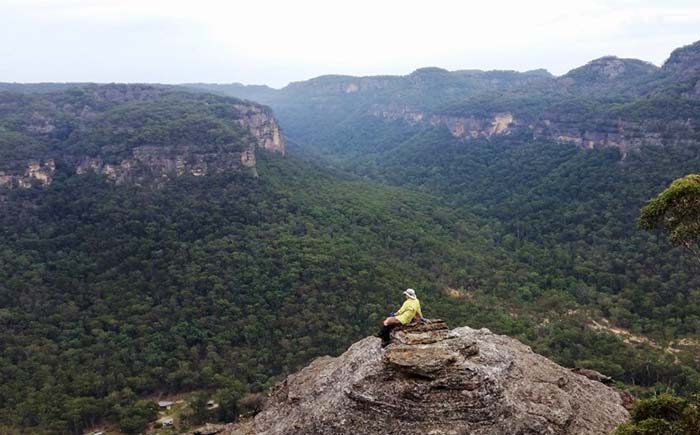
Looking down Little Capertee Creek Valley from Mystery Mountain Lookout, Newnes. Photo:Trevor Jones
After a rest day in Lithgow and Tim returning to Adelaide we were off to Newnes for our real adventure in the Gardens of Stone and Wollemi National Parks. The weather was still hot so we opted for the cooler walk along the Wolgan River to see the Totem Pole (GR 576 199) first. This would take three days and two nights’ base camping at Rocky Creek. Unfortunately a grader had been through the week before us. It severely churned up the area to lay dog bait every 500 metres and certainly took the wilderness edge off our walk. Regardless, that first day was highlighted by a side trip up the beautiful Starlight Canyon on the northern side of the Wolgan River just past Devil’s Pinch. We reached our Rocky Creek campsite in a sudden deluge of rain that went as quickly as it came so we settled in for the night listening to the wild dogs up on the plateau. We came to appreciate the serious effort of the dog baiting.
The day walk to the Totem Pole was successful as it can be like finding a needle in a haystack. First of all we boulder hopped from the end of the road for about a kilometre then it was fair going to the Annie Rowan Creek, Wolgan River confluence. We found that following the Wolgan River’s southern edge from the creek was relatively easy although rocky and we made good progress. Returning from Annie Rowan Creek we followed an old track or more like, “where would a vehicle have gone from here” and found our way steadily back to the Wolgan River after descending a short reinforced embankment.
We should have crossed the Wolgan River here (GR557 229) but instead we boulder hopped back on the southern side to the end of the road again. I’m sure the old vehicle track would have continued back along the northern side at the point where it met the Wolgan River and I expect it should have been easy going rather than the boulders again but we opted for the safer option of known information from the track notes in the book.
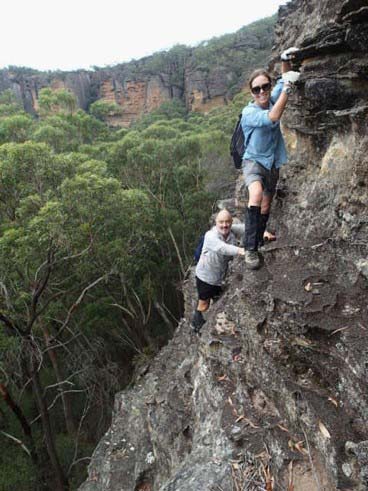
Nino and Tracey ascending the Pagoda on Mystery Mountain. Photo: Lorraine Thomas
Returning to Newnes we stayed two nights at the public camp ground so we could tackle the Mystery Mountain walk. After climbing the pagodas at the lookout the boys were aching to do more so after following the route along a terrace dividing the cliff face we ascended a pagoda (GR 436 247) onto the plateau instead of the gully indicated in the book, it was one of those “what am I doing here moments”. It is not for the faint hearted but it turned out not so bad after all, so we then descended the lovely Zobel’s Gully and followed the Glow Worm Tunnel track back to Newnes.
Water was scarce in this area, and the creeks were dry so our grand trek that was originally planned was reduced to base camps. Our next foray was a three night camp in a small clearing along the northern branch of Capertee Creek by a permanent spring. To get there we passed through the private property “Red Cliffs” obtaining permission from the owner beforehand who also imparted some valuable knowledge which was used over the coming days.
It was such a peaceful place, rarely visited, with an abundance of birds from the tiny Pardalote to the Goshawk. At night, around the campfire, the late stayers were entertained by a Squirrel Glider making its way through the trees and the next day we were rewarded with a sighting of the rare Brush Tail Rock Wallaby. This was a truly undisturbed and tranquil piece of nature’s paradise. From this camp we did day walks to Mt Dawson and the Minotaur Lair. It was hard going and even harder to navigate.
A lot can happen in this terrain within 100 metres when you are limited to a 6 figure grid reference but we found our way, slowly, usually out for about 8 hours each day. We planned to do more which would include the Mt Dawson Caves and Gindantherie Pinnacle but navigating this country is a slow and exacting process and we had to adhere to our “turn around” time or risk finding our way back in the dark, not a good option in this terrain. At one stage we lost satellite contact, at the same point our compasses were affected by an iron stone pagoda pulling about 10 degrees and to complicate matters there was a lot of confusion within our GPS track log. The most difficult challenge in this country is finding the right slot, gully or pagoda to ascend or descend the plateau to get to your objective. This takes careful planning, exploration and teamwork but you are rewarded with mammoth vistas, striking rock formations, contrasts in vegetation, wild life at its best and all this is complemented by the spiritual ambience of this beautiful wilderness.
Thomas Ebersol, who runs a kiosk from the Newnes Hotel, now his private residence, always welcomed us back from each escapade. We could enjoy hot showers, tea and coffee or even an ice cream while we talked of our adventures, I think he enjoyed our company as much as we did his. Thomas also stored our excess gear and we collected our drinking water from him, all for a modest donation. His knowledge of the area is invaluable and he loves to share it from the history of the old Newnes Township to the way of route to a particular destination.
After our final return to Newnes we filled in the rest of our day exploring Petries Gully and the Old Newnes Ruins, a must see, before returning to Lithgow where another two walkers departed while the rest prepared for the next phase of our journey.
Our next adventure was based in Wollemi National Park. I had decided from our previous exploits that the terrain was too difficult to pack walk through to the Dumbano Creek Tunnels and Camp Cave with so few walkers left so we were able to enjoy ourselves in comfort at Deep Pass base camp, the weather had cooled and there was an abundance of water!
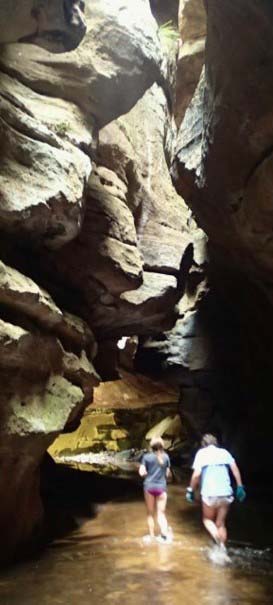
Tracy and Jude in the River Caves Canyon Wollemi National Park, photo: Lorraine Thomas
The foot tracks here are hard to find if you don’t know what you are looking for but we eventually made our way to River Caves Canyon on a foot pad all the way from Deep Pass. Next day it rained and we had planned to ascend Mt Norris but decided the way up was too slippery so we started our circuit in reverse via Window Rock. The rain continued and it was unpleasant progress or lack of and we did not find the actual rock with the window. To complicate matters I was starting to get cold so we decided to return to camp and explore its surrounds. Split Rock is located about 200 metres east of the campground and is referred to as Mini Standley Chasm and on the opposite side of the creek, we viewed some indigenous rock paintings of the traditional owners of the Wywandy and Wiradjuri Tribes.
Our last day was a circuit through the beautiful Nayook Canyon complete with fish and a handsome yabby. The foot pad starts on the right of the main (northern) track to the camp ground just before it crosses Nayook Creek and can be easily missed.
The difficult sections through the canyon have permanent ropes and logs set up, although I did find myself testing them first for strength. This allowed us to contour around the pristine rock pools and over the waterfalls enabling us to continue all the way through to the carpark and then it was back to Lithgow for the last night of our trip.
In between locations we stayed at Lithgow Caravan Park and they could not have been more helpful allowing us to leave our excess gear in our cabins, including refrigerated goods. That chilled chardonnay or a beer on our return was a real treat. Madjestic Tours operates from the Lithgow Caravan Park and the indefatigable Nicholas took care of all our transport needs including supermarket shopping and going out to dinner. Together with the sound advice from members of the NSW walking clubs and the ongoing help from Michael Keates and some property owners we were able to enjoy a very safe and exhilarating time in this largely unexplored paradise.The area is so unique and mostly undisturbed, showcasing rare and endangered species. This compels the adventurous bushwalker to come and explore but despite all its beauty it is threatened by development proposals. With the sage advice in the nine volumes of “The Gardens of Stone National Park and Beyond” the greater bushwalking community can now plan trips to the area before it is lost to development. It’s time to get out there and help extend the awareness of this wonderful and exciting place.

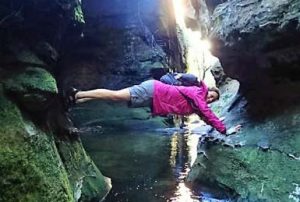
Comments (0)